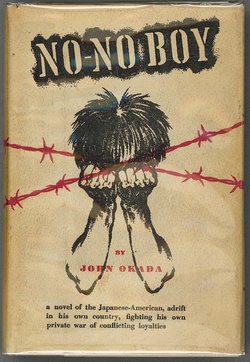No-No Boy is a novel written by John Okada, a second-generation Japanese-American who lived in America during the Pacific War. He died in 1971 at the age of 47, and this is his only work. From the perspective of a Japanese-American who experienced the war, Okada explores a variety of themes, including identity, family, nation, race, and the individual. We will explore the world of this novel, which is still read today, and its appeal and significance.
The novel "No-No Boy" was published in 1957 by Charles E. Tuttle Publishing, which has headquarters in the United States and Tokyo. The company was founded in 1948, and its founder, Charles E. Tuttle, came to Japan after the war at the behest of General Douglas MacArthur, Supreme Commander of the Allied Powers, to revive the Japanese publishing industry, and also worked on the import of foreign books and magazines.
In addition to the content of the work, the fact that the author, Okada, was of Japanese descent and had been stationed in Japan as a U.S. soldier may have been related to the fact that it was published by Tuttle Publishing, but the details of how it was published are not known.
"No-No Boy," published in the United States as an American novel, is a hardcover book with 308 pages. The cover features a rough-tongued picture of a man covering his face with both fists, with barbed wire drawn on top of it, giving the impression of intense suffering. It brings to mind a person imprisoned in some kind of prison or concentration camp, as mentioned in the book.
From the question of national loyalty
After the Japanese military attacked Pearl Harbor in December 1941, Japanese and Japanese-Americans in the United States were treated as enemy aliens, and from the following year, all people of Japanese ancestry living on the West Coast of the United States were sent to internment camps. The U.S. government then issued a "Loyalty Questionnaire" to all adult inmates.
There were 33 questions, with question 27 asking men of draft age, "Are you willing to serve in the United States Armed Forces to perform combat duty wherever located?", and question 28 asking all prisoners, "Do you unconditionally pledge allegiance to the United States of America, to defend it against attack by hostile powers, foreign and domestic, and to refuse to pay allegiance to or obedience to the Emperor of Japan or any other foreign government, authority, or organization?"
Those who answered "No" to these two questions were later called "No-No Boys." Overall, they were a minority, and the reason for this was not simple. Also, many Japanese Americans fought on the battlefield and some were killed, and so prejudice and discrimination against the "No-No Boys" was born.
Set in post-war Seattle
The novel is set in Seattle, Washington, just after the Pacific War. It depicts the struggles of the young protagonist, Yamada Ichiro, a second-generation Japanese American who was born and raised in Seattle, Washington, a city with a long history of Japanese immigration. Both of Ichiro's parents are first-generation immigrants from Japan, and his mother is a fanatic who loves Japan and does not believe that Japan lost the war. His father can only watch his mother's abnormal behavior and drowns his frustration with alcohol.
Perhaps out of consideration for his mother's feelings, Ichiro refuses to be drafted and goes to prison when the war begins and many Japanese Americans join the military. The story begins after the war ends, when Ichiro leaves prison and returns to Seattle.
Around Ichiro appear people who are still scarred by the war in various ways. Through his interactions with them, Ichiro continues to worry about the decisions he made and desperately searches for who he is, someone who is neither Japanese nor American, and what kind of life he should lead from now on.
While his mother is proud of his decision, his younger brother Taro is ashamed of his brother's actions and volunteers for the military. When his mother finds out, she commits suicide immediately after. The reader follows the whereabouts of Ichiro's wandering soul, wondering where he is headed next.
Although Ichiro is not technically a No-No Boy because he refused to be drafted and served his sentence, the word was probably used in the title because he can be seen as a No-No Boy in the sense that he turned his back on America, faced discrimination and prejudice, and struggled with how to live after the war. It can also be interpreted as a No-No Boy in a broader sense.
Not accepted and forgotten?
The first edition was published in 1,500 copies. Unfortunately, the background and theme of the novel were not yet accepted by Japanese American society, as the shadow of war still lingered. Sales of the book were poor, and the publisher has not sold out the copies even after 20 years.
Okada never published another work before his sudden death from a heart attack 13 years later, meaning his first and last work had barely been talked about by the public before he died, and "No-No Boy" was left buried and forgotten.
However, in 1970, one year before his death, a young writer came across the book at a bookstore in San Francisco's Japantown, shedding light on this hidden masterpiece.
(Titles omitted)
© 2016 Ryusuke Kawai







